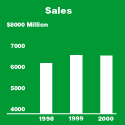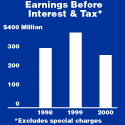 |
2000 was a distinctly different year from the
first to the second half. In the first half of the year, we
posted profit after taxes of $103 million and earned $2.70
per share; in the second half, profit after taxes was $8 million
and earnings per share fell to 21 cents, excluding a pre-tax
charge of $160 million in the fourth quarter. The erosion
in profit was due to a sudden and pronounced downturn in a
number of markets, reflecting the overall uncertainty of today's
economy.
Heavy-duty engine shipments in North America
fell 39 percent from the first to the second half of the year.
In the fourth quarter, shipments of our mid-range engine to
DaimlerChrysler were 25,000 units, down from an average of
31,000 units for the first three-quarters of the year, as
DaimlerChrysler cut production of its Dodge Ram pickup truck.
In North America, shipments of midrange truck engines declined
24 percent from the first to the second half of the year.
During that same period, shipments of engines to the North
American construction market declined 28 percent, and sales
of engines to the recreational vehicle market were down 18
percent. The decline in the heavy-duty engine business also
affected exhaust systems sales in our Filtration business,
which fell 13 percent from the first to the second half.
In past years, this kind of downturn would
have meant large losses for the Company. The fact is that
we broke even in the fourth quarter on an operating basis.
We are a much different company than we were even a year ago,
and are now seeing the benefits of the diversification and
cost reduction strategies we have pursued. The businesses
and markets which account for over 80 percent of our revenues
are profitable and growing, and we are working to ensure that
the remaining 20 percent will be profitable in the future.
Let me review our businesses with you.
Business Overview
 Power Generation (21 percent of revenue, 41 percent of EBIT)
has moved from a break-even business just 3 years ago to one
that was able to nearly double its profits over 1999. We project
10 to 15 percent growth in Power Generation over the next
few years, fueled by rising global demand for power from ready
sources. The energy issues in the American West highlight
even more the need for reliable power and full service support.
Power Generation (21 percent of revenue, 41 percent of EBIT)
has moved from a break-even business just 3 years ago to one
that was able to nearly double its profits over 1999. We project
10 to 15 percent growth in Power Generation over the next
few years, fueled by rising global demand for power from ready
sources. The energy issues in the American West highlight
even more the need for reliable power and full service support.
 Filtration and Other Business (18 percent of revenue, 49 percent
of EBIT) remained solidly profitable, despite being affected
by the depressed heavy-duty engine market. We are gaining
market share as original equipment manufacturers (OEMs) respond
favorably to the natural synergy among our engine, filtration,
and exhaust products.
Filtration and Other Business (18 percent of revenue, 49 percent
of EBIT) remained solidly profitable, despite being affected
by the depressed heavy-duty engine market. We are gaining
market share as original equipment manufacturers (OEMs) respond
favorably to the natural synergy among our engine, filtration,
and exhaust products.
- The "other' in this category refers to our
19 company-owned distributors across the globe, which represent
strategic growth opportunities for Cummins. This year, we
added three new distributors, two in Latin America and one
in South Africa. As a group, we expect them to continue
to grow at 10 percent each year over the next several years.
- Also included in this category is our turbocharger
business, Holset. It grew 26 percent in sales and doubled
in profits over the year. Holset continues to play a critical
role in our emissions technology research and development.
- Together, these two businesses provide the
best return on assets of all of our businesses.
 The Engine Business (61 percent of revenue, 10 percent of
EBIT) posted operating earnings of $24 million for the full
year, reflecting strong segments in the group:
The Engine Business (61 percent of revenue, 10 percent of
EBIT) posted operating earnings of $24 million for the full
year, reflecting strong segments in the group:
- High-horsepower engine sales for mining,
rail equipment, and government applications are 18 percent
higher than a year ago, and growing.
- Despite the recent slump in the light-duty
automotive business, our 13-year relationship with DaimlerChrysler
has never been better. DaimlerChrysler acknowledges that
Cummins is one of its best suppliers. We have also continued
to improve our performance in quality and in reducing costs.
- Although down in the second half, shipments
to construction, agriculture and marine markets were still
4 percent higher than a year ago.
- Shipments of heavy-duty and midrange truck
engines in international markets increased 18 percent.
- This brings us to the heavy-duty truck engine
market in North America, which fell 39 percent in 2000.
The Engine Business worked diligently throughout the year
to mitigate the effects of the downturn in that market,
consolidating facilities, reducing its workforce, and continuing
to reduce costs.
Top Of
Page
2001 and Beyond
As I write this letter, we've had only a few
weeks to view our performance for 2001. We expect the first
quarter of 2001 to be worse than the fourth quarter of 2000.
The truck market will likely be down another 20 percent, and
other consumer markets are also softening. To address this
immediate issue, we will continue to reduce our costs through
streamlining and consolidating production, and reducing our
workforce.
Over the next several years, our focus will
be on improving cash flow, restructuring the way we participate
in the heavy-duty truck market, and growing our profitable
businesses. This focus will position us for strong financial
performance as we emerge from the economic slump.
To improve our cash flow, we continue to reduce
our direct and indirect material costs, and have already delivered
approximately $275 million worth of improvements in our gross
purchase costs since our work began in 1998. Reducing the
amount we pay for quality issues associated with some of our
new products is also a focus, and we have implemented a quality
improvement program called Six Sigma. Led by project leaders
called Black Belts and Green Belts, Six Sigma uses statistical
tools and a disciplined, logical approach to drive rapid process
improvement. We now have more than 100 Black Belts and 170
Green Belts working on improvement projects. The completed
projects have already resulted in an additional $27 million
to the bottom line, exceeding our first-year goal by $2 million.
Throughout 2000, I have highlighted the need
to change the way we participate in the North American heavy-duty
truck engine market. The problems in the business are inherent
in the structure, and are not only the result of the current
downturn. For more than a decade, we have been caught between
discounts in pursuit of market share and the need for significant
investment in technology over shorter and shorter product
cycles driven by increasingly stringent emissions standards.
This cycle means that neither Cummins nor other participants
in that market, including truck manufacturers and component
suppliers, can earn a reasonable return on this investment,
even in a strong year. This is why we are all considering
new relationships, so that we can remove these redundant costs
and restore profitability over the long term. Cummins is working
hard to establish the kind of relationships that will enable
us to earn a return on our investment, and I am optimistic
about our ability to do so.
I am confident of our future as we move into
2001, despite the challenges of 2000. Our strengths remain.
We are a diversified company. We continue to lead the industry
in emissions technology, with expertise in fuel systems, filtration,
exhaust systems, turbochargers, electronics, and combustion
research. We have manufacturing, engineering, and marketing
alliances that not only cross our organizational structure,
but which cross the globe, including ten businesses in India
and eight in China. We have the strongest distribution system
among any of our competitors, which enables us to be first
to market with the best products. We intend to capitalize
and build upon these strengths.
The year 2000 was an important year for Cummins.
We took action to address the short-term financial issues
facing us, worked to strengthen our growth businesses, and
established a new Vision and Mission which resulted in changing
our name to Cummins Inc. to reflect the true nature of the
company. These actions, combined with our focus on our strengths
over the long term, mean that we are well poised to deliver
on our promise to perform for all our stakeholders in 2001
and beyond.

Tim Solso
Chairman and Chief Executive Officer
Cummins Engine Company, Inc.
February 28, 2001
|
 |






